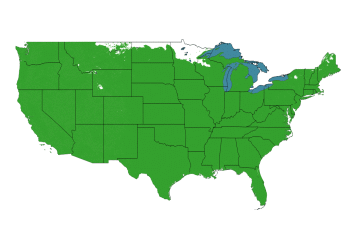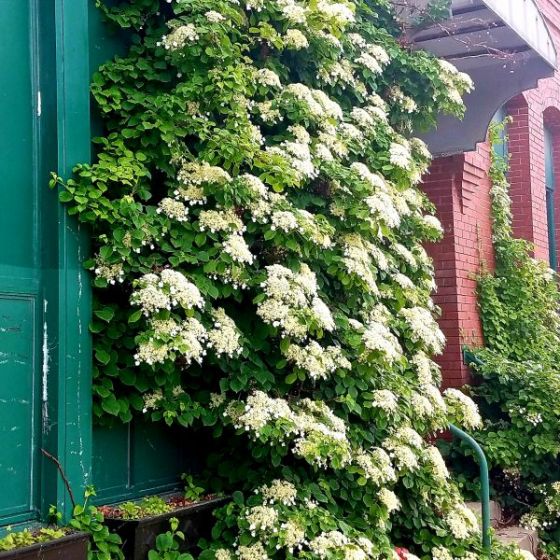✖
Climbing Hydrangea
Hydrangea anomala petiolaris
As low as
$0.00
In stock
SKU
PFY-3992
Climbing Hydrangea Vine Fragrant Blooms in Shade
- Grows in Shade
- Four Seasons of Interest
- Wonderfully Fragrant Flowers, Leaves, Stems
- Pretty White Flowers from Late Spring and Early Summer
- Lush, Dark Green Summer Foliage Turns Yellow for Fall
- Exfoliating Bark Delivers Winter Interest
- Attracts Butterflies
- Long-Lived and Easy Care
- Blooms Last for Long Bloom Period
- Loves Hot Humid Conditions
- Grows in Full Shade and Part Sun
- Great Cut Flowers Fresh and Dried
If you have more shade than sun, or just have a few shady spots to decorate, try the easy care Climbing Hydrangea (Hydrangea anomala petiolaris). This perennial vine produces beautiful white lace cap flowers in late spring and early summer. And it blooms in shade! How nice to finally be able to brighten up those dimly lit areas in your landscape.
Climbing Hydrangea vine is an extremely versatile vine with year-round interest. Glossy green summer foliage turns brilliant yellow as a nice fall color feature. The exfoliating, reddish-brown bark of mature plants is attractive in winter.
Get ready to see butterflies visiting the wide, flat pretty lace cap flower clusters to gather nectar. All parts of this pretty plant are fragrant, too. And it thrives in shady conditions, can you believe it?
As you might imagine, this desirable plant is in high demand. Our growers are thrilled to offer this plant, but you should hurry. We will sell out of this selection quickly.
Climbing Hydrangea is native to wooded forests, streams and shaded mountain slopes of Japan, China and South Korea. With prolific production of large flowers in late spring and early summer, this unique climbing vine does take a bit of time to get established.
Please be patient. Once the roots are nestled into your soil, look out. It takes off like a rocket!
Flowering vines that bloom their heads off in shade are almost impossible to find. Vigorous, easy care Climbing Hydrangea plants are rare, and people across the country are on the hunt for them.
If you see them in stock on our website, be sure to place your order as soon as you can. You'll be competing with other homeowners who also want to use this special variety to brighten up their shady landscapes. Order now!
How to Use Climbing Hydrangea in the Landscape
Many professional horticulturists agree that there is no better climbing vine than the Climbing Hydrangea. Use this plant for climbing on arbors, fences or the trunks of large trees, and over walls. It also can be grown as a ground cover in shady areas or on steep embankments.
Climbing Hydrangea is one of the best vines for clinging to brick or stone walls. It can be particularly effective when grown against building walls where it can easily attach and cling to the surface using its aerial rootlets.
This is also a great selection for espalier in a flat fan shape along the back fence. What a treat for your guests!
If grown on a house, plan to cut around windows and doorways to create a wonderful Fairy Tale cottage or castle. We are sure your imagination is working overtime! Have fun with this wonderful plant.
You'll love to perfume your home with the flowers for fresh cut arrangements. Allow them to dry for fabulous dried flower displays. Or, just enjoy the reddish-brown dried flower heads on the plant for texture and visual interest.
It's modified roots will attach to almost any surface. Climbing Hydrangea also can be grown as a flowering groundcover in shady areas or on steep embankments. When left unsupported, the plant mounds to about 3 feet tall and will scramble over the ground. That's much safer and prettier than trying to mow turf on a slope.
On a slope, plant near the top, and point the plants downhill. Plant 6 feet apart on center, measuring from the center of one to the center of the next. Manage their growth by positioning new stems downhill as needed. Keep mass plantings mulched and weeded as they fill in. Add additional rows 20 - 30 feet further downhill.
#ProPlantTips for Care
These lovely vines grow well in moist, well-drained soils with plenty of organic matter added to planting. It prefers an acid soil of 6 to 6.5 but is adapted to a wide range of soil types as long as the drainage is good.
They are very cold hardy but will need a moderate amount of regular water. Use the Finger Test to see if they need additional water. Push your finger into the soil up to the second knuckle. Is it getting dry? Give it a long drink. Still moist? Skip watering that day.
Climbing Hydrangea will not do well in full sun, give it a partial shade setting for the best results. In colder Zone 5 or in high humidity climates, it can handle more direct morning sun with afternoon shade. If you live in a drier climate or in Zones 8, 9 and 10, you should plant in full shade. Mulch the root zone 3 to 4 inches deep to keep surface roots consistently moist and cool.
Please note that they do take time to get established in your soil. This plant is slow to establish but once it gets well rooted in the ground, the vigor improves dramatically. It is also slow to come into flower, so please remember that patience is a virtue.
They definitely fit that old garden adage "the first year they sleep, the second year they creep and the third year they leap!" Once they start leaping for you, there is no stopping these vigorous plants. Give it a very sturdy structure to grow on. They'll add so much beauty to shady spots around your yard.
The plant is nearly disease and pest free. The most common problem being chlorosis caused by higher pH soils. Fertilize with Dr. Earth's Acid Lovers Natural and Organic Premium Fertilizer in the fall and after blooming to keep plant healthy and soil pH acidic.
It blooms on last year's wood, so prune right after its blooms start to fade in the late spring to early summer. Left alone, Climbing Hydrangea develops a bushy, informal habit. Keep it neat and uniform with regular light summer pruning.
Finding Climbing hydrangea for sale can be a challenge. Buy yours from LetsPlantify.com before we sell out!
| Botanical Name | Hydrangea anomala petiolaris |
|---|---|
| Mature Height | 4 - 6 feet |
| Mature Spread | 5 - 6 feet |
| Soil Type | Widely Adaptable |
| Moisture | Moderate |
| Sun Exposure | Full Shade, Partial Shade |
| Growth Rate | Slow, then Fast |
| Bloom Period | Late Spring, Summer |
| Flower Color | White |
| Foliage Color | Green |
| Fall Color | Yellow |
| Pollinator Required | No |
| Pollinator Friendly | Yes |
| Growing Zone Range | 4-10 |

Write Your Own Review

